Revoking access to IAM Roles Anywhere using open-source private CA
A step-by-step guide on revoking access to IAM Roles Anywhere using open-source private CA, also published as a blog post.

Introduction
IAM Roles Anywhere (IAMRA) is an AWS service providing a certificate authentication option for users or machines outside of AWS, to gain permissions within AWS.
For example, an on-premise server might run a daily backup job writing to a S3 bucket, or a mobile medical device could connect via mobile networks to stream health information to a database.
IAMRA requires a certificate authority (CA) to act as a trust store and to issue end user or device certificates. One option is AWS Private CA, however this is expensive at $400 per month + $0.75 per certificate.
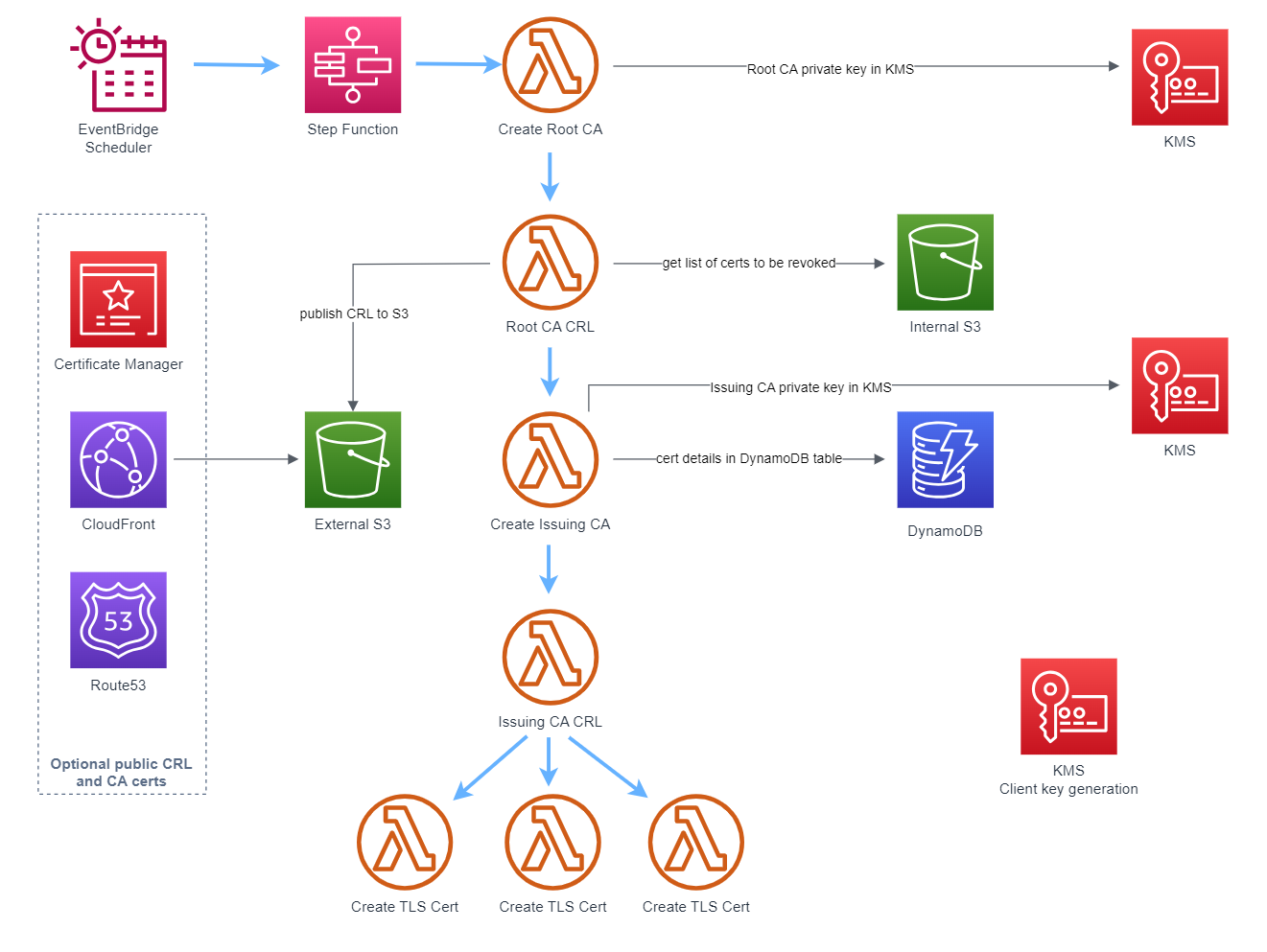
In 2024 we released an open-source serverless private cloud CA with costs typically under $5 per month, and provided a guide to setting up IAM Roles Anywhere using the CA.
Why revocation is important
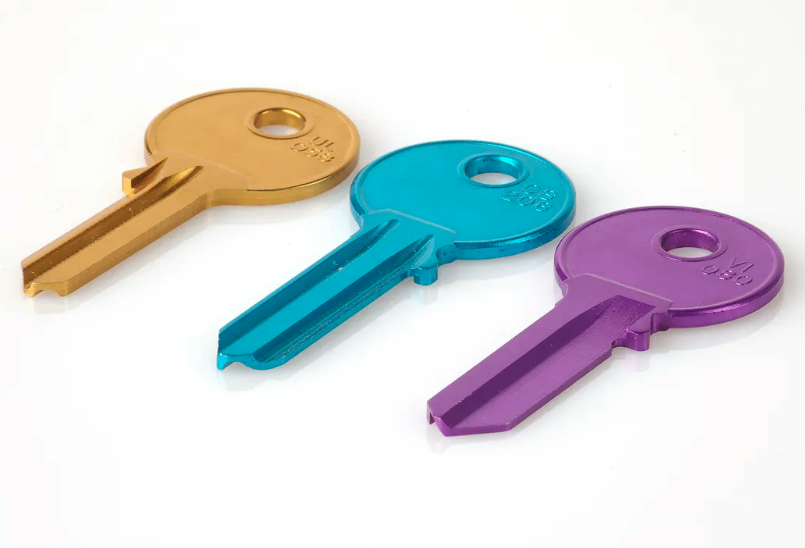
For a robust security solution, it’s important to have a method of revoking access, in the event that the user or device certificate private key is compromised — for example if a physical device or server is stolen.
This post provides a walkthrough of how to revoke a certificate using the open-source serverless CA, import the Certificate Revocation List (CRL) to IAMRA, and test.
Set up CA and connect using IAMRA
Begin by following the guide to setting up the serverless CA, and after that, the guide to configuring IAMRA.
Ensure you reach the point where you execute a command to check AWS identity:
aws sts get-caller-identity --profile secops
You should receive a response like this:
{
"UserId": "AROAXXXXXXXXXXXXXX:1111111111111111111111111111111",
"Account": "012345678901",
"Arn": "arn:aws:sts::012345678901:assumed-role/roles-anywhere-s3-full-access/61d5692c1982239b82255b38e6ced2aa34712ff0"
}
Identify certificate details
Now we’re ready to test certificate revocation with IAMRA.
Look up certificate details locally on your laptop:
openssl x509 -noout -text -in 'certs/client-cert.crt'
You should get a response like this:
Certificate:
Data:
Version: 3 (0x2)
Serial Number:
22:b7:47:12:77:a9:52:91:35:b0:e1:47:cb:94:02:63:b6:37:c1:35
Signature Algorithm: ecdsa-with-SHA256
Issuer: CN=Cloud Issuing CA, C=GB, L=London, O=Cloud CA, OU=Security Operations
Validity
Not Before: Mar 22 07:12:52 2025 GMT
Not After : Jun 20 07:17:52 2025 GMT
Subject: CN=My Test Certificate, C=GB, L=London, O=Serverless Inc, OU=Security Operations, ST=England
Subject Public Key Info:
Public Key Algorithm: id-ecPublicKey
Public-Key: (256 bit)
pub:
04:57:f1:ef:92:95:62:61:c9:77:ad:05:ea:68:3f:
4f:90:ed:ce:75:a5:93:9d:d8:cb:af:26:4d:77:39:
4b:55:c1:26:29:92:ed:11:17:99:53:d2:fe:8e:22:
20:4d:f2:67:79:50:7c:4b:54:3c:57:7a:ef:fd:f1:
b9:78:26:7e:ef
ASN1 OID: prime256v1
NIST CURVE: P-256
X509v3 extensions:
X509v3 Key Usage: critical
Digital Signature, Key Encipherment
X509v3 Extended Key Usage:
TLS Web Client Authentication
X509v3 Certificate Policies:
Policy: 2.23.140.1.2.1
X509v3 Subject Key Identifier:
42:55:6E:81:41:62:32:17:81:18:8C:6C:2A:96:04:EF:8D:D0:91:0C
X509v3 CRL Distribution Points:
Full Name:
URI:http://certs.cloud-ca.com/serverless-issuing-ca-dev.crl
Authority Information Access:
CA Issuers - URI:http://certs.cloud-ca.com/serverless-issuing-ca-dev.crt
Signature Algorithm: ecdsa-with-SHA256
Signature Value:
30:44:02:20:16:31:73:9f:00:84:cb:2e:32:75:85:e3:c0:ef:
af:65:df:e9:f5:af:99:0d:6c:96:74:60:21:c6:4f:bd:03:14:
02:20:3d:88:7d:5a:6a:b8:5b:fa:4a:81:f2:96:55:3b:ba:3d:
6b:a9:b7:8a:57:e8:18:84:c6:05:97:74:83:ae:01:2a
If the device has recently used IAMRA, certificate details can also be obtained by logging in to the AWS account and region in which IAMRA is configured. Select IAM, Roles Anywhere, Subject Activity:
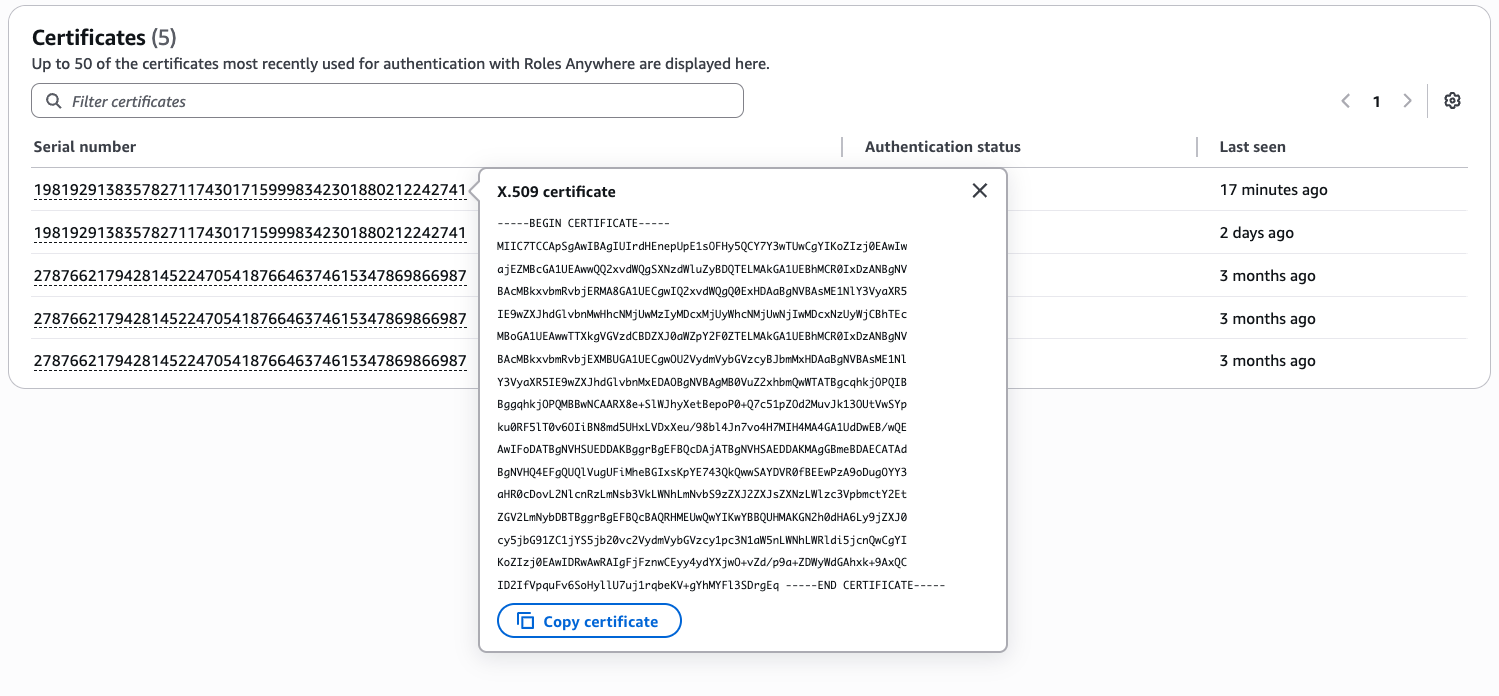
Create Pull Request
To revoke the certificate, submit a Pull Request to the repository used to deploy the serverless CA with details of the certificate to be revoked, added to certs/{ENVIRONMENT_NAME}/revoked.json:

Revoke certificate
To revoke the certificate, run the deploy pipeline which will update revoked.json in the internal S3 bucket.
Wait till the next scheduled execution of the CA step function, or execute manually or via a pipeline step:
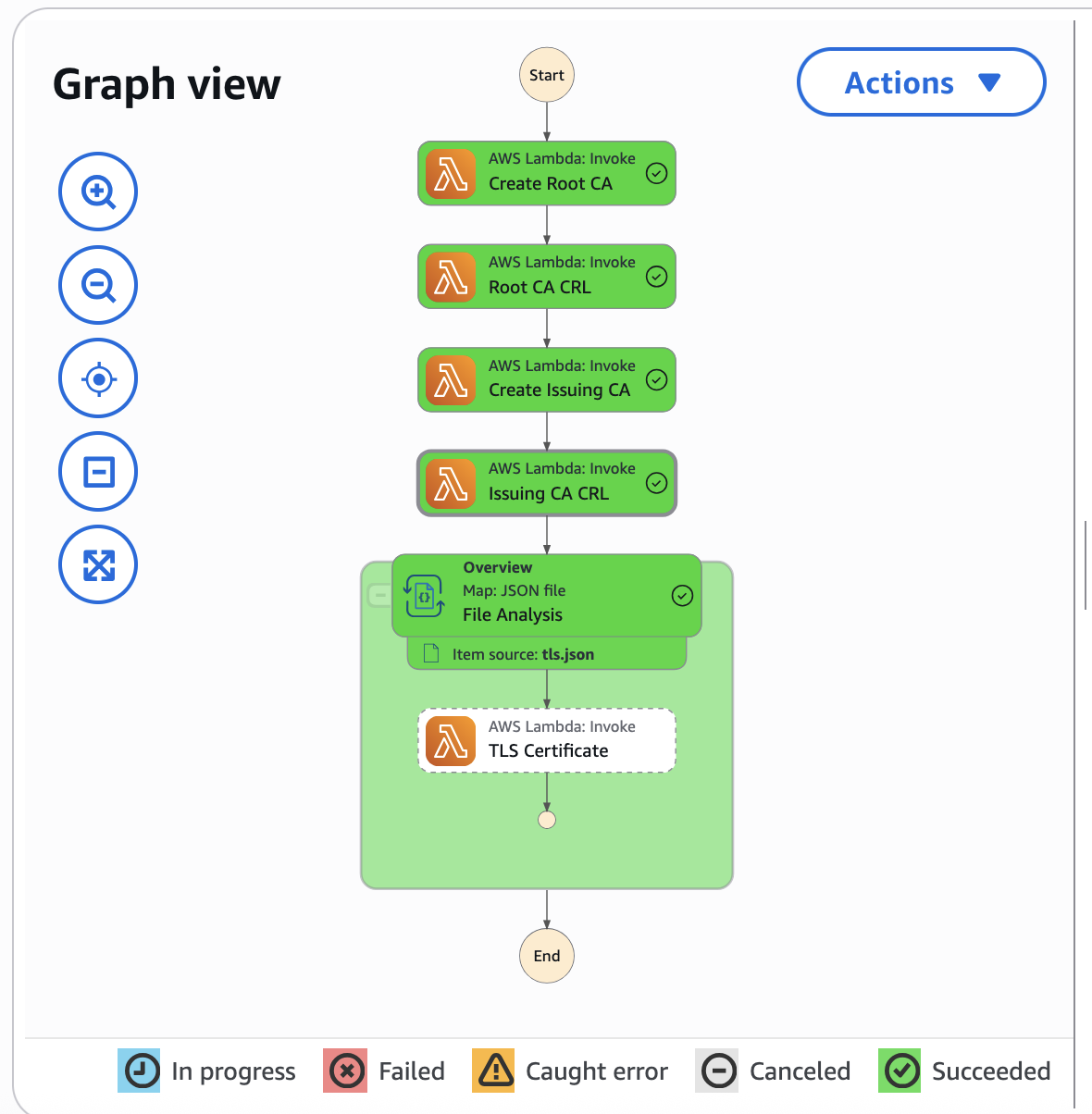
Check CRL
Wou can check the CRL includes the specified certificate by locating the file in the “external” S3 bucket within the CA AWS account. Alternatively if you’re publishing the CRL publicly, download from the CRL distribution point (CDP) for the Issuing CA CRL, e.g. https://certs.cloud-ca.com/serverless-issuing-ca-dev.crl.
The .crl file is in DER format, and can readily be viewed on a Windows operating system:
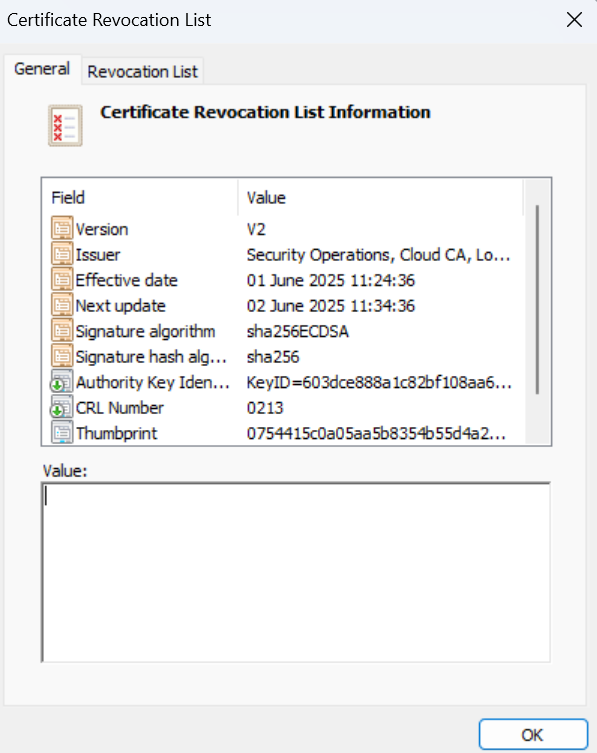
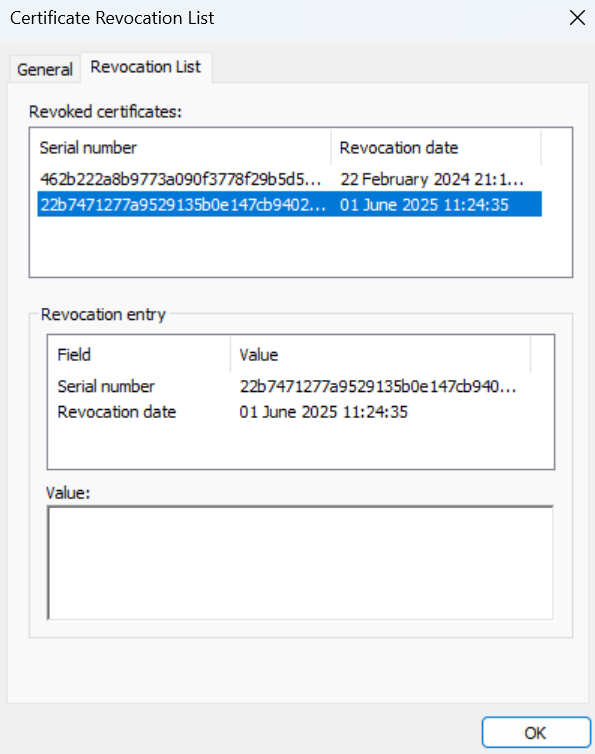
If you’re using MacOS or Linux, you can view using open SSL:
openssl crl -text -noout -in ~/Downloads/serverless-issuing-ca-dev.crl -inform DER
Certificate Revocation List (CRL):
Version 2 (0x1)
Signature Algorithm: ecdsa-with-SHA256
Issuer: CN=Cloud Issuing CA, C=GB, L=London, O=Cloud CA, OU=Security Operations
Last Update: Jun 1 10:24:36 2025 GMT
Next Update: Jun 2 10:34:36 2025 GMT
CRL extensions:
X509v3 Authority Key Identifier:
60:3D:CE:88:8A:1C:82:BF:10:8A:A6:40:76:9F:DD:38:1A:E5:1E:87
X509v3 CRL Number:
531
Revoked Certificates:
Serial Number: 462B222A8B9773A090F3778F29B5D5BB9DEF983B
Revocation Date: Feb 22 20:16:26 2024 GMT
Serial Number: 22B7471277A9529135B0E147CB940263B637C135
Revocation Date: Jun 1 10:24:35 2025 GMT
Signature Algorithm: ecdsa-with-SHA256
Signature Value:
30:46:02:21:00:aa:45:58:96:e4:03:71:57:0e:2f:9d:8e:6d:
0b:d7:a2:ef:60:73:23:8f:08:22:77:80:c7:cf:8f:b1:c8:08:
20:02:21:00:cd:b9:e7:a6:98:c0:65:27:13:05:c6:92:0d:1c:
b3:56:7d:db:77:2c:37:63:31:76:8e:e2:26:ca:09:45:e3:38
Download CRL in PEM format
The serverless CA publishes CRLs in both DER format with a .crl file extension, and in PEM format with .crl.pem extension.
If your serverless CA CRL is public, download the CRL in PEM format from the location for the Issuing CA CRL, e.g. https://certs.cloud-ca.com/serverless-issuing-ca-dev.crl.pem.
Otherwise, locate and download the file from the “external” S3 bucket.
Import CRL to IAM Roles Anywhere
At the present time, there’s no visibility of the CRL functionality for IAMRA within the AWS console, so we need to use the AWS CLI or other AWS SDK.
In the AWS account in which you’ve configured IAMRA, import the CRL in PEM format, for example:
aws rolesanywhere import-crl --crl-data $(base64 -i ~/Downloads/serverless-issuing-ca-dev.crl.pem) --name "Serverless Issuing CA Dev" --trust-anchor-arn "arn:aws:rolesanywhere:eu-west-2:012345678901:trust-anchor/2de9dfa7-9f39-40c2-ae31-aaf843684dc9" --output json
Example response:
{
"crl": {
"createdAt": "2025-06-01T14:20:10.510727+00:00",
"crlArn": "arn:aws:rolesanywhere:eu-west-2:012345678901:crl/3a4d71af-5bc8-4749-a47b-66e9d1e3bd58",
"crlData": "LS0tLS1CRUdJTiBYNTA5IENSTC0tLS0tCk1JSUJkakNDQVJzQ0FRRXdDZ1lJS29aSXpqMEVBd0l3YWpFWk1CY0dBMVVFQXd3UVEyeHZkV1FnU1hOemRXbHUKWnlCRFFURUxNQWtHQTFVRUJoTUNSMEl4RHpBTkJnTlZCQWNNQmt4dmJtUnZiakVSTUE4R0ExVUVDZ3dJUTJ4dgpkV1FnUTBFeEhEQWFCZ05WQkFzTUUxTmxZM1Z5YVhSNUlFOXdaWEpoZEdsdmJuTVhEVEkxTURZd01URXdNalF6Ck5sb1hEVEkxTURZd01qRXdNelF6Tmxvd1RqQWxBaFJHS3lJcWk1ZHpvSkR6ZDQ4cHRkVzduZStZT3hjTk1qUXcKTWpJeU1qQXhOakkyV2pBbEFoUWl0MGNTZDZsU2tUV3c0VWZMbEFKanRqZkJOUmNOTWpVd05qQXhNVEF5TkRNMQpXcUF3TUM0d0h3WURWUjBqQkJnd0ZvQVVZRDNPaUlvY2dyOFFpcVpBZHAvZE9CcmxIb2N3Q3dZRFZSMFVCQVFDCkFnSVRNQW9HQ0NxR1NNNDlCQU1DQTBrQU1FWUNJUUNxUlZpVzVBTnhWdzR2blk1dEM5ZWk3MkJ6STQ4SUluZUEKeDgrUHNjZ0lJQUloQU0yNTU2YVl3R1VuRXdYR2tnMGNzMVo5MjNjc04yTXhkbzdpSnNvSlJlTTQKLS0tLS1FTkQgWDUwOSBDUkwtLS0tLQo=",
"crlId": "3a4d71af-5bc8-4749-a47b-66e9d1e3bd58",
"enabled": false,
"name": "Serverless Issuing CA Dev",
"trustAnchorArn": "arn:aws:rolesanywhere:eu-west-2:012345678901:trust-anchor/2de9dfa7-9f39-40c2-ae31-aaf843684dc9",
"updatedAt": "2025-06-01T14:20:10.510727+00:00"
}
}
Enable CRL in IAM Roles Anywhere
Enable the new CRL in IAMRA using the crlId value from the previous command response:
aws rolesanywhere enable-crl --crl-id 3a4d71af-5bc8-4749-a47b-66e9d1e3bd58 --output json
Response:
{
"crl": {
"createdAt": "2025-06-01T14:20:10.510727+00:00",
"crlArn": "arn:aws:rolesanywhere:eu-west-2:012345678901:crl/3a4d71af-5bc8-4749-a47b-66e9d1e3bd58",
"crlData": "LS0tLS1CRUdJTiBYNTA5IENSTC0tLS0tCk1JSUJkakNDQVJzQ0FRRXdDZ1lJS29aSXpqMEVBd0l3YWpFWk1CY0dBMVVFQXd3UVEyeHZkV1FnU1hOemRXbHUKWnlCRFFURUxNQWtHQTFVRUJoTUNSMEl4RHpBTkJnTlZCQWNNQmt4dmJtUnZiakVSTUE4R0ExVUVDZ3dJUTJ4dgpkV1FnUTBFeEhEQWFCZ05WQkFzTUUxTmxZM1Z5YVhSNUlFOXdaWEpoZEdsdmJuTVhEVEkxTURZd01URXdNalF6Ck5sb1hEVEkxTURZd01qRXdNelF6Tmxvd1RqQWxBaFJHS3lJcWk1ZHpvSkR6ZDQ4cHRkVzduZStZT3hjTk1qUXcKTWpJeU1qQXhOakkyV2pBbEFoUWl0MGNTZDZsU2tUV3c0VWZMbEFKanRqZkJOUmNOTWpVd05qQXhNVEF5TkRNMQpXcUF3TUM0d0h3WURWUjBqQkJnd0ZvQVVZRDNPaUlvY2dyOFFpcVpBZHAvZE9CcmxIb2N3Q3dZRFZSMFVCQVFDCkFnSVRNQW9HQ0NxR1NNNDlCQU1DQTBrQU1FWUNJUUNxUlZpVzVBTnhWdzR2blk1dEM5ZWk3MkJ6STQ4SUluZUEKeDgrUHNjZ0lJQUloQU0yNTU2YVl3R1VuRXdYR2tnMGNzMVo5MjNjc04yTXhkbzdpSnNvSlJlTTQKLS0tLS1FTkQgWDUwOSBDUkwtLS0tLQo=",
"crlId": "3a4d71af-5bc8-4749-a47b-66e9d1e3bd58",
"enabled": true,
"name": "Serverless Issuing CA Dev",
"trustAnchorArn": "arn:aws:rolesanywhere:eu-west-2:012345678901:trust-anchor/2de9dfa7-9f39-40c2-ae31-aaf843684dc9",
"updatedAt": "2025-06-01T14:22:43.269195+00:00"
}
}
The CRL is now shown as enabled.
Test certificate revocation
Test by repeating the command used at the beginning of this article:
aws sts get-caller-identity --profile secops
Access is denied to the identity, with the reason “Certificate revoked”.
Error when retrieving credentials from custom-process: 2025/06/01 15:24:50 AccessDeniedException: Certificate revoked
👏 🎉 🎊 Congratulations, you’ve tested certificate revocation for AWS IAM Roles Anywhere with the open-source private CA 🎆 🌟 🎇